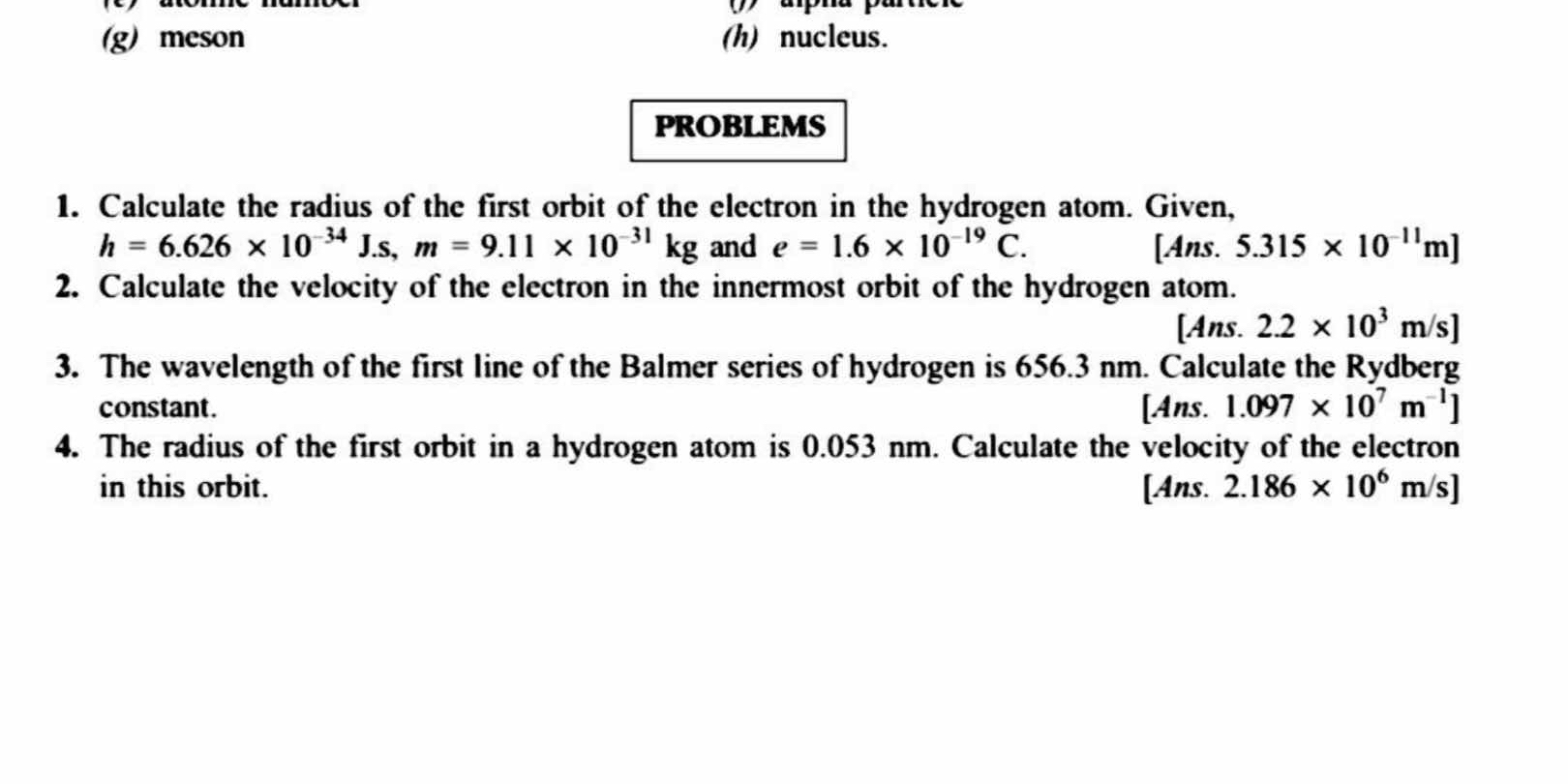1. Calculate the radius of the first orbit of the electron in the hydrogen atom. Given, h = 6.626 × 10⁻³⁴ J.s, m = 9.1 × 10⁻³¹ kg and e = 1.6 × 10⁻¹⁹ C. 2. Calculate the velocity o... 1. Calculate the radius of the first orbit of the electron in the hydrogen atom. Given, h = 6.626 × 10⁻³⁴ J.s, m = 9.1 × 10⁻³¹ kg and e = 1.6 × 10⁻¹⁹ C. 2. Calculate the velocity of the electron in the innermost orbit of the hydrogen atom. 3. The wavelength of the first line of the Balmer series of hydrogen is 656.3 nm. Calculate the Rydberg constant. 4. The radius of the first orbit in a hydrogen atom is 0.053 nm. Calculate the velocity of the electron in this orbit.

Understand the Problem
The question consists of several problems related to the hydrogen atom, dealing with calculations of the radius of the first orbit, velocity of the electron, wavelength of the Balmer series line, and Rydberg constant. This will involve applying principles of quantum mechanics and atomic structure.
Answer
1. $5.315 \times 10^{-11} \, \text{m}$ 2. $2.2 \times 10^{3} \, \text{m/s}$ 3. $1.097 \times 10^{7} \, \text{m}^{-1}$ 4. $2.186 \times 10^{6} \, \text{m/s}$
Answer for screen readers
-
The radius of the first orbit is approximately $5.315 \times 10^{-11} , \text{m}$.
-
The velocity of the electron in the innermost orbit is approximately $2.2 \times 10^{3} , \text{m/s}$.
-
The Rydberg constant is approximately $1.097 \times 10^{7} , \text{m}^{-1}$.
-
The velocity of the electron in the given orbit (radius $0.053 , \text{nm}$) is approximately $2.186 \times 10^{6} , \text{m/s}$.
Steps to Solve
- Calculating the Radius of the First Orbit
The formula for the radius of the first orbit in a hydrogen atom is given by:
$$ r_1 = \frac{n^2 h^2}{4 \pi^2 m e^2} $$
For the first orbit, $n = 1$. Substituting the given values:
- ( h = 6.626 \times 10^{-34} ) J.s
- ( m = 9.1 \times 10^{-31} ) kg
- ( e = 1.6 \times 10^{-19} ) C
$$ r_1 = \frac{1^2 (6.626 \times 10^{-34})^2}{4 \pi^2 (9.1 \times 10^{-31}) (1.6 \times 10^{-19})^2} $$
- Calculating the Velocity of the Electron in the Innermost Orbit
The velocity of the electron in the innermost orbit can be calculated using:
$$ v = \frac{e^2}{2 \epsilon_0 h} $$
Where ( \epsilon_0 ) (vacuum permittivity) is approximately ( 8.854 \times 10^{-12} , \text{C}^2/\text{N m}^2 ).
Substituting values:
$$ v = \frac{(1.6 \times 10^{-19})^2}{2 (8.854 \times 10^{-12}) (6.626 \times 10^{-34})} $$
- Calculating the Rydberg Constant
The Rydberg constant ( R_H ) can be calculated using the wavelength of the first line of the Balmer series, ( \lambda = 656.3 ) nm, where ( 1 , \text{nm} = 1 \times 10^{-9} ) m. The formula is:
$$ R_H = \frac{1}{\lambda} $$
Substituting in:
$$ R_H = \frac{1}{656.3 \times 10^{-9}} $$
- Calculating the Velocity of the Electron in the Given Orbit
For the given radius ( r = 0.053 , \text{nm} = 0.053 \times 10^{-9} , \text{m} ), the velocity can be calculated using:
$$ v = \frac{e^2}{2 \epsilon_0 r} $$
Substituting in:
$$ v = \frac{(1.6 \times 10^{-19})^2}{2 (8.854 \times 10^{-12}) (0.053 \times 10^{-9})} $$
-
The radius of the first orbit is approximately $5.315 \times 10^{-11} , \text{m}$.
-
The velocity of the electron in the innermost orbit is approximately $2.2 \times 10^{3} , \text{m/s}$.
-
The Rydberg constant is approximately $1.097 \times 10^{7} , \text{m}^{-1}$.
-
The velocity of the electron in the given orbit (radius $0.053 , \text{nm}$) is approximately $2.186 \times 10^{6} , \text{m/s}$.
More Information
The hydrogen atom is the simplest atom, consisting of only one proton and one electron. The calculations for radius, velocity, and the Rydberg constant help us understand fundamental atomic properties and quantization in quantum mechanics. The values calculated here are vital for understanding atomic spectra and quantum mechanics applications.
Tips
- Confusing the units (e.g., nm to m).
- Misapplying the formulas; ensure the correct formula is used for each specific calculation.
- Not using the right constants; be cautious with ( h ), ( m ), and ( e ) values as they are critical for accuracy.
AI-generated content may contain errors. Please verify critical information